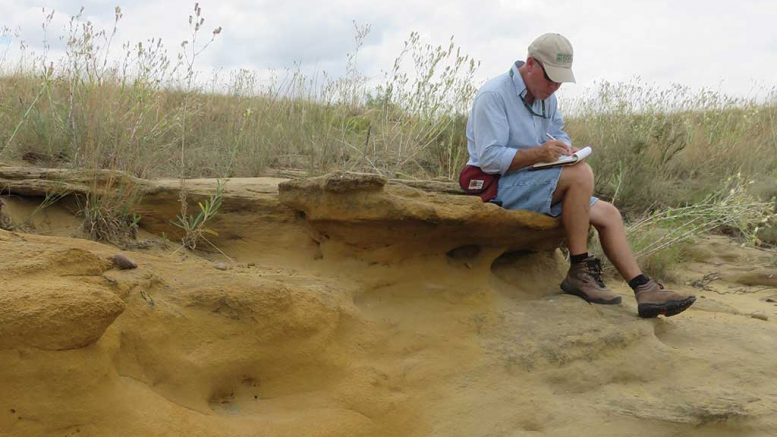VANCOUVER — The U.S. Geological Survey (USGS) estimates there are 39.9 million lb. of undiscovered uranium oxide resources in the Southern High Plains region of Texas, New Mexico and Oklahoma.
The uranium occurs within calcrete — a type of carbonate-rich rock formation prolific in uranium-producing countries like Australia and Namibia. The deposit is the first of its kind to be reported in the United States.
“It’s exciting because it’s a whole new uranium province in the U.S.,” Susan Hall, a uranium resource specialist at the USGS and lead author of the newly released report titled “Assessment of undiscovered resources in calcrete uranium deposits,” tells The Northern Miner during a phone interview from the USGS’s regional office in Denver, Colorado.
Nuclear power accounts for 19% of electricity production in the U.S., yet only 11% of uranium purchased by the country’s power reactors in 2016 came from domestic sources.
Hall, who just returned from an annual meeting with the Uranium Group in Paris, France, says that while the near-term outlook for uranium demand appears bleak, having a domestic source of uranium in the U.S. is “important if there’s any future restriction of supply.”

USGS geologist Bradley Van Gosen sampling calcrete near the Sulfur Springs Draw uranium deposit in Texas. Credit: USGS.
“The U.S. is the world’s largest consumer of uranium, even though there’s more expansion going on in Asia,” she says. “Most of the U.S. mines are on standby status or pretty much headed that way because our uranium is so high-cost to produce. Kazakhstan can produce uranium for US$9 a pound whereas the U.S. mines are more close to US$25 to US$40 a pound. So obviously we’re buying our uranium from elsewhere.
“Having a domestic source for running all our reactors is certainly a good idea … the U.S. has all the facilities to process the material, the only problem is finding enough inexpensive uranium to mine here.”

The USGS study has divided the region into two prospective tracts: north and south. The southern track contains the majority of the USGS’s 40 million lb. U3O8 estimate. Credit: USGS.
The USGS was drawn into the Southern High Plains after discovering that calcrete uranium resources worldwide fall within arid climatic belts, where evaporations rates tend to be highest.
The deposits form when uranium-enriched groundwater evaporates, leaving behind a hard-pan crust of uranium and carbonate minerals.
“We had one geologist who looked at the calcrete resources worldwide and noticed they lined up at 30 degrees latitude north and south, adjacent to uranium provinces where there might be a source,” Hall says. “His idea was that, if it’s an evaporative system, the Southern High Plains would be a great place to look.”
After sleuthing through historical reports, the USGS became aware of two unreported calcrete uranium deposits in Texas — Sulphur Springs Draw and Buzzard Draw — which have a combined historical resource of 2.6 million lb. U3O8.
The group then used a three-part method to calculate the probable amount of undiscovered calcrete uranium in the region based on known resources, in combination with geological features and existing geological models.

USGS geologist Bradley Van Gosen sampling calcrete near the Sulfur Springs Draw uranium deposit in Texas. Credit: USGS.
The area was divided into the northern and southern tracts, with the southern tract covering parts of Texas and New Mexico accounting for 80% of the 39.9 million lb. U3O8 estimate.
Calcrete uranium deposits occur near surface where evaporation rates are the highest, making them ideal candidates for low-cost, shallow open-pit mining.
However, they tend to be lower grade — in the parts per million range — unlike the Athabasca basin region in Saskatchewan, where grades can exceed 30% U3O8.
The world’s largest calcrete uranium deposit — Cameco’s (TSX: CCO; NYSE: CCJ) Yeelirrie in Western Australia — is undeveloped, but contains a historical resource of 139 million lb. U3O8 at 0.13% U3O8 in the measured and indicated category, and 5 million lb. U3O8 at 0.10% U3O8 as inferred.
Other examples include Paladin Energy’s (TSX: PDN) Langer Heinrich former mine in western Namibia’s Namib desert, where ore extends for 15 km in a paleochannel system, some 50 metres deep. The deposit has reserves of 46,500 tonnes U3O8, at a cut-off of 0.01% U3O8. Langer Heinrich has been in production since 2006 but the company switched to processing stockpiles in 2016.
The USGS expects to publish a guide on how to explore for these deposits in the U.S. in the coming months, which Hall says would “prove useful” should they become more economic in the future.
“It’s a really cool detective story,” she says. “The other thing we’ve noticed is that you could have all the evaporation in the world, but you’re not going to get uranium to drop out unless you have vanadium in the groundwater. I’m not sure how it works — or if anyone really knows — but it seems like the vanadium helps the uranium to precipitate.”


Be the first to comment on "USGS identifies new uranium potential in southern US"